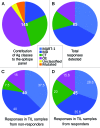TIL therapy broadens the tumor-reactive CD8(+) T cell compartment in melanoma patients
- PMID: 22754759
- PMCID: PMC3382882
- DOI: 10.4161/onci.18851
TIL therapy broadens the tumor-reactive CD8(+) T cell compartment in melanoma patients
Abstract
There is strong evidence that both adoptive T cell transfer and T cell checkpoint blockade can lead to regression of human melanoma. However, little data are available on the effect of these cancer therapies on the tumor-reactive T cell compartment. To address this issue we have profiled therapy-induced T cell reactivity against a panel of 145 melanoma-associated CD8(+) T cell epitopes. Using this approach, we demonstrate that individual tumor-infiltrating lymphocyte cell products from melanoma patients contain unique patterns of reactivity against shared melanoma-associated antigens, and that the combined magnitude of these responses is surprisingly low. Importantly, TIL therapy increases the breadth of the tumor-reactive T cell compartment in vivo, and T cell reactivity observed post-therapy can almost in full be explained by the reactivity observed within the matched cell product. These results establish the value of high-throughput monitoring for the analysis of immuno-active therapeutics and suggest that the clinical efficacy of TIL therapy can be enhanced by the preparation of more defined tumor-reactive T cell products.
Figures






References
-
- Sznol M, Powderly JD, Smith DC, Brahmer JR, Drake CG, McDermott DF, et al. Safety and antitumor activity of biweekly MDX-1106 (Anti-PD-1, BMS-936558/ONO-4538) in patients with advanced refractory malignancies. ASCO Annual Meeting Proceedings 2010; 28:2506.
-
- Yang A, Kendle RF, Ginsberg BA, Roman R, Heine AI, Pogoriler E, et al. CTLA-4 blockade with ipilimumab increases peripheral CD8+ T cells: Correlation with clinical outcomes. ASCO Annual Meeting Proceedings 2010; 28:2555.
Publication types
LinkOut - more resources
Full Text Sources
Other Literature Sources
Medical
Molecular Biology Databases
Research Materials
